How to See the Liberty Bell...in Queens
A copy of the famous American bell can be found inside a bank, which itself is modeled after Independence Hall!



Despite a population of more than 2.5 million people that is still growing, Brooklyn still boasts a long list of abandoned locations that beg for discovery. These buildings, once fruitful and prosperous, have fallen into disrepair and now lay abandoned in various stages of decay. Similar to abandoned buildings in The Bronx, many of these spots have caught the eyes of ambitious developers yearning to give the spot a new life. However, shadows of their former lives remain. Here are 10 abandoned places to discover throughout Brooklyn.
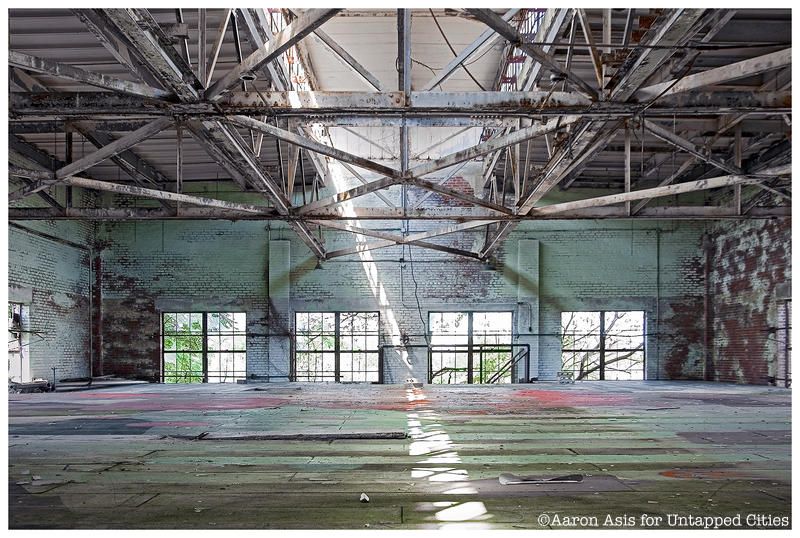
Brooklyn’s Barren Island is home to Floyd Bennett Field, New York’s first municipal airport, which was built in 1931. Sections of the site have been abandoned since the United States Navy deactivated the airfield in 1971. In its heyday, Floyd Bennett Field saw ascents by historic aviators, such as Amelia Earhart and Howard Hughes. With this kind of a storied history, the airfield naturally lends itself to having a few secrets.
Named after Floyd Bennett, a World War I aviator who was recruited to pilot an expedition to the North Pole, the airfield has been the site of many historic flights. One of the most notable flights was Howard Hughes’ 1938 departure to circumnavigate the Earth in record time. In 1941, the airfield shifted from a municipal airport to a Naval Air Station, where those who made and tested aircraft worked during World War II. The airfield soon became the busiest naval air station in the United States. However, following World War II, the NYPD and FDNY made use of the facilities for storage. Today, the airfield is a national park open daily from 6 a.m. to 9 p.m.

Just next to Floyd Bennett Field sits Dead Horse Bay, whose macabre name aptly describes its history. Before the area was landfilled to create Floyd Bennett Field, Dead Horse Beach was once a separate island known as Barren Island. In 1859, the first horse rendering plants were constructed on Barren Island, which processed dead horses by mashing them up, steaming them, separating the products, and boiling their bones down into glue. The remnants became commercial fertilizer. This was seen as a better alternative to the ongoing practice, where horses were simply left to rot and decompose on New York City’s streets. Originally, Barren Island was considered ideal for this noxious activity because it was so remote that nobody would complain about the smell.
Later, Barren Island was also used to deal with the city’s garbage problem. Prior to the formation of the New York Sanitary Utilization Company, trash was dumped into the waterways. Motivated by financial reasons — the garbage was getting in the way of ship traffic — the city selected Barren Island for the processing and disposal of trash. Similar to the horses, the trash would be boiled and steam cooked until a layer of grease emerged at the top to be skimmed off and sold for industrial lubrication and soap. But with encroaching development, even Barren Island became too close for comfort due to the smell. The stench, which could reach a radius of six to ten miles, would waft over to beachgoers on Manhattan Beach where hotel evacuations would occur. Unsurprisingly, neighboring communities began complaining and locals formed the Anti-Barren Island League. The landfill ceased operation in the 1940s and was capped off in 1953, but the waste emerges on a daily basis due to erosion, leaving a beach of strewn bottles, old toys, and shoes. Today, Dead Horse Bay is closed to the public due to the presence of radiological contamination.
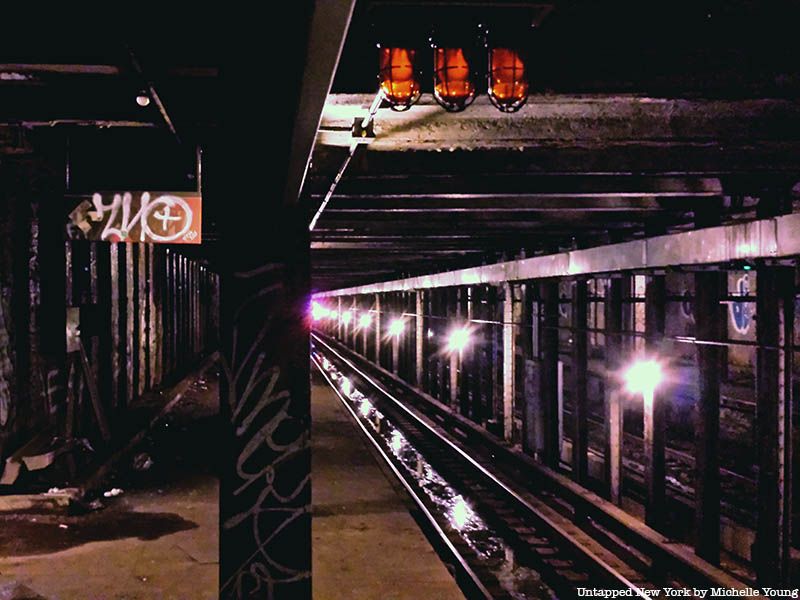
In Brooklyn, an abandoned level below the Bergen Street station is a favorite spot for urban explorers. This level is part of one of many New York City subway stations that have abandoned platforms. In the early 1990s, renovations to the station, which serves the F and G trains, damaged the lower platform, which had been used from time to time since 1933. Silver doors on the upper level conceal open staircases that go down to the lower level.
While many of the signs have been taken by urban explorers, one key piece of signage left shows how Bergen was abbreviated into Bergn. Urban explorer @Vic.Invades shared, “The station was so cold to the point where you can see icicles frozen in time on the ceiling. You can also hear the civilians above you laughing and talking about whatever they experienced that day, while I lingered below in an empty, filthy, abandoned station. As I was down below there was a work train just sitting at the other end. You can’t really see it because it was above the incline that leads you into the station.”
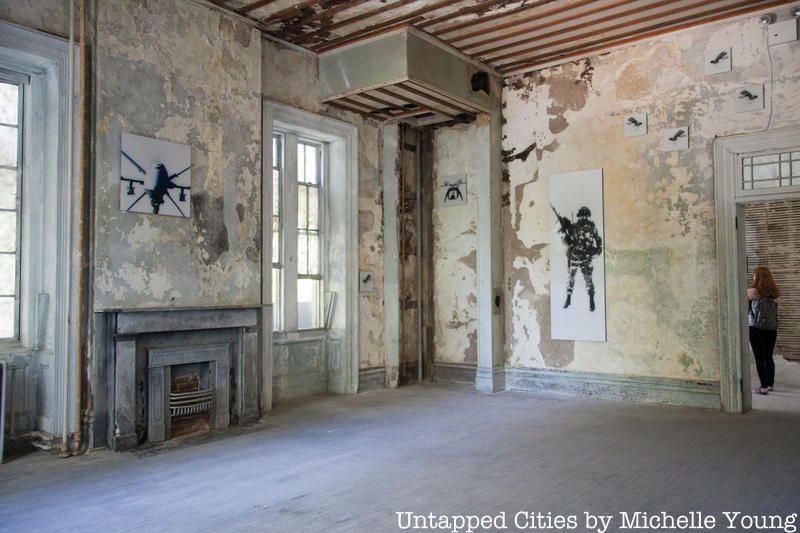
The Brooklyn Navy Yard Naval Hospital Annex — or the Naval Annex — was built from 1830 to 1836. It was active from the Civil War, during which it supplied almost a third of the medicine distributed to Union soldiers, and through both World Wars. The hospital is also notable for employing some of the first female nurses and medical students. Dr. E. R. Squibb, the leading pharmaceutics inventor and part-name sake of the pharmaceutics company Bristol-Myers Squibb, developed the first anesthetic ethers for use in surgery.
By the 1970s, the Brooklyn Navy Yard Naval Hospital Annex was decommissioned. Today, it is one of the few original buildings that remain at the Navy Yard. Steiner Studios, a major anchor tenant there, is working on transforming the space into a 420,000-square-foot media campus by 2027. Compared to Ellis Island‘s abandoned hospital complex, the Brooklyn Navy Yard Naval Hospital Annex is less well-traveled. Other abandoned hospitals across New York City include the Roosevelt Island Smallpox Hospital and Seaview Hospital on Staten Island.
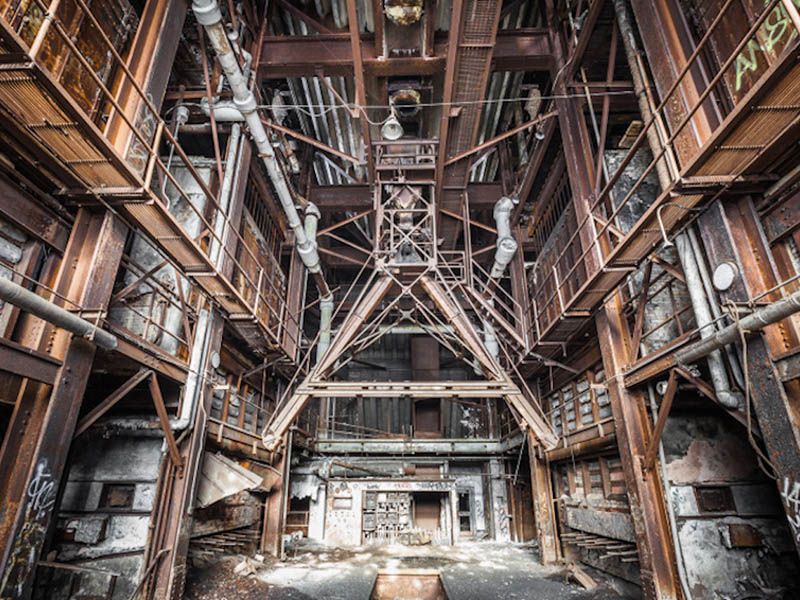
In an undisclosed location within Brooklyn lies the Jumping Jack Power Plant. Little is known about this towering abandoned building, which has become dilapidated over time and is now covered in layers of rust and dirt. The building’s first graffiti-ridden floor appears to have been a former chop shop, with a battered car now covered in spray paint residing there. This first floor also boasts many rickety staircases not suitable for climbing, but a rare passable staircase leads to the building’s main floor. According to Will Ellis of AbandonedNYC, paper records found inside the building indicate that the last time the power plant was in operation was in 1963. Ellis believes that the building was open to trespassers for a number of years before being sealed up in the ’80s or ’90s, preserving an image of a “grittier New York.”
Once you reach the main floor of the building, a four-story gallery of machinery becomes visible. The steel pipes and beams have turned to various shades of orange after what is most likely to be a century’s worth of aging, It is within this area of the building that Jumping Jack gets its name: a configuration of steel beams stretching the four stories of the gallery create what looks to be a figure doing a jumping jack. The actual purpose of the Jumping Jack man remains a mystery. While readers might be wondering where this abandoned spot is and how they can get there, the precise location of Brooklyn’s Jumping Jack Power Plant has been kept a closely guarded secret by all explorers who have been able to locate it. To head Will Ellis’ warning, “‘Undiscovered’ or not, this place is still pretty under the radar, and I’d like to keep it that way for now.”
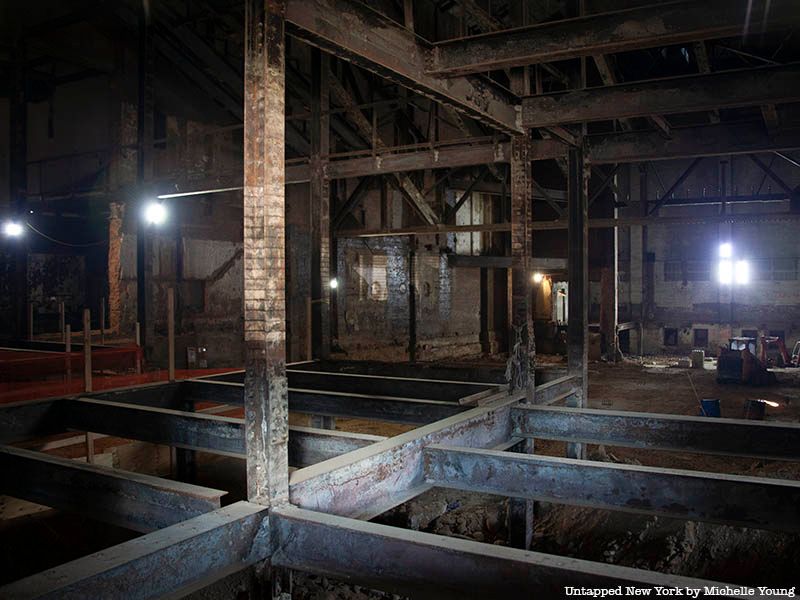
Located in Borough Park, Brooklyn, Loew’s 46th St. Theatre was a movie palace that went through multiple life cycles between 1927 and 1973. The now-abandoned theater opened as the Universal Theater on October 9, 1927 to a huge, disorderly crowd of 25,000 people waiting for a spot in the 3,000-seat theater. Many even resorted to sitting on the fire escapes just to peek at the beautiful interior. Designed by renowned theater architect John Eberson, it was New York’s first “atmospheric theater.” Eberson’s design emulated a starry, night sky over an Italian garden. Decorated with painted gold and a blue dome, the theater felt like an open-air auditorium with twinkling stars and other “atmospheric effects” being projected onto it.
The rise of multiplex cinema in the 1960s caused the theater to fall into hard times. Eventually, the theater became a music venue known as the “Brooklyn Rock Palace.” Artists including the Grateful Dead, Jefferson Airplane, and the Byrds performed there. However, by 1973, the theater closed following community pressure regarding noise levels. The year after, it was sold to a furniture company whereupon significant changes were made to the interior, including the removal of the stage. The auditorium became a storage area for the furniture business, while the lobby became a showroom.
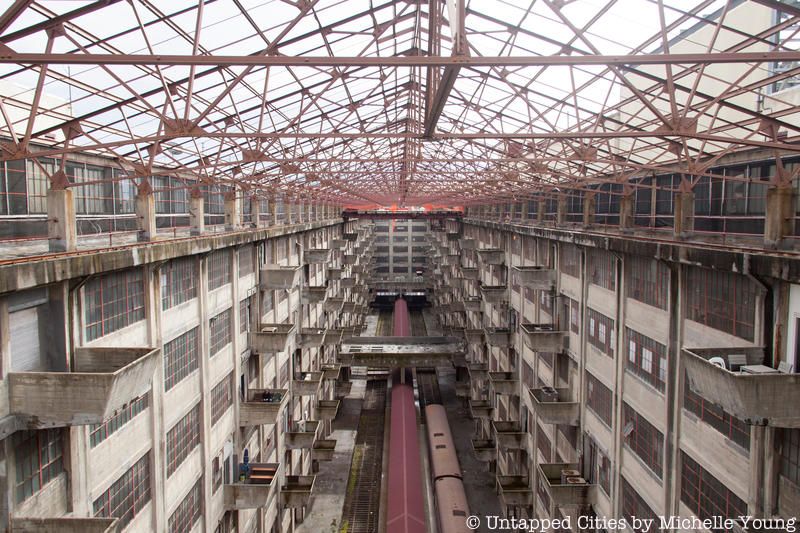
The Brooklyn Army Terminal, located in Sunset Park, was the largest military supply base in the United States until World War II. Designed by Cass Gilbert, the architect behind the Woolworth Building, the complex was completed in 1919 and remained in operation until the 1970s. In 1981, the federal government sold the site to New York City, which began leasing the property to businesses.
A multi-decade renovation of the terminal by NYCEDC has transformed it into a light manufacturing and office complex that is home to food startups, biotech companies, artist studios, and more. The grounds have undergone a savvy redesign by WXY Architecture that created a more welcoming outdoor space. Rooftop Films also hosts drive-in movie nights on the terminal’s pier. While many locations at the Brooklyn Army Terminal are no longer abandoned, there are still locations inside that remain in their raw state, including World War II towers on the roof, an abandoned admin building, a skybridge, and more.

On the waterfront of Gravesend, Brooklyn, a place without a name still stands within a labeled city. The untraveled wedge of vacant land is nestled between aging marinas and the northern border of Calvert Vaux Park on Bay 44th St. It’s a place we can only call “the secret park,” but there’s no mention of it on the department’s website. In its place, Google maps only shows a dull gray transected by the mysterious Westshore Avenue, though no such road exists.
The small peninsula was born out of the construction of the Verrazano Bridge in the 1960s when excavated material from the project was deposited on the shore of Gravesend Bay. Most of the new land was incorporated into the existing Drier-Offerman Park, but for some reason, this small finger of land was left out of the plan. Through the 1970s, it served as an illegal junkyard, but by 1982, developers came forward with a plan to construct a seaside residential development at the site. Apparently, the project never came to fruition. The city of New York suggests environmental remediation as a condition for future development. We wager that it won’t be long before the development potential of the site is realized, but for the time being, the unkempt wilds of the secret park offer a rustic alternative to the paved walkways and manicured lawns of our city parks.
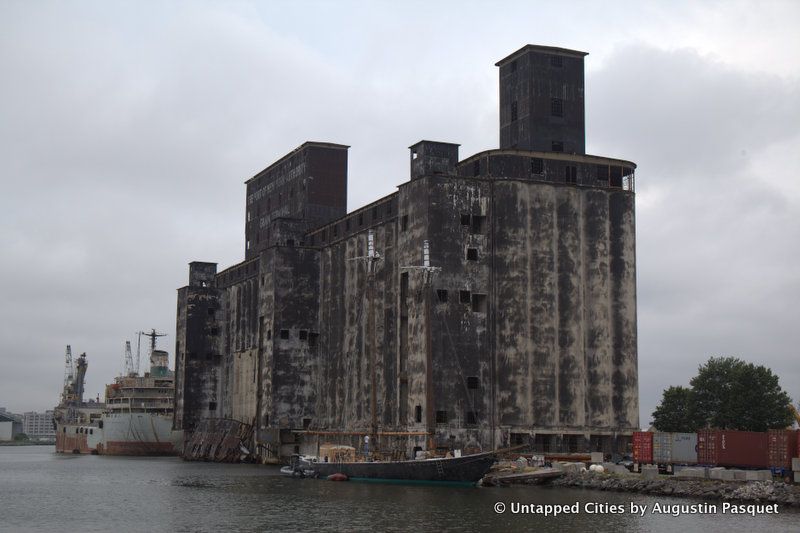
It’s been nearly fifty years since freighters docked at the Red Hook Grain Terminal. Now black mold overspreads its concrete silos like a mourning veil. Its origins can be traced to the 20th-century construction of the New York State Barge Canal, which widened and rerouted the Erie Canal to facilitate the latest advances in shipping. By 1918, New York City was lagging behind in the nation’s grain trade and the canal was failing, operating at only 10 percent of its capacity. This state-run grain elevator in the bustling industrial waterfront of Red Hook, Brooklyn was built in the Port of New York to invigorate the underused waterway. The structure is largely composed of 54 circular silos with a combined capacity of two million bushels. In its heyday, grain was mechanically hoisted from the holds of ships, elevated to the top of the terminal, and dropped into vertical storage bins through a series of moveable spouts.
In the second half of the 20th century, the collapse of the grain trade was just a portion of the overall decline along Red Hook’s industrial waterfront as shipping methods evolved and moved elsewhere. When the jobs dried up, much of the area cleared out, leaving a slew of vacant warehouses and decaying docks. The Grain Terminal has been the subject of a number of reuse proposals over the years, but none of the plans have amounted to real progress at the site. The building sits on the grounds of the Gowanus Industrial Park, which currently houses a container terminal and a bus depot, among other industrial tenants.
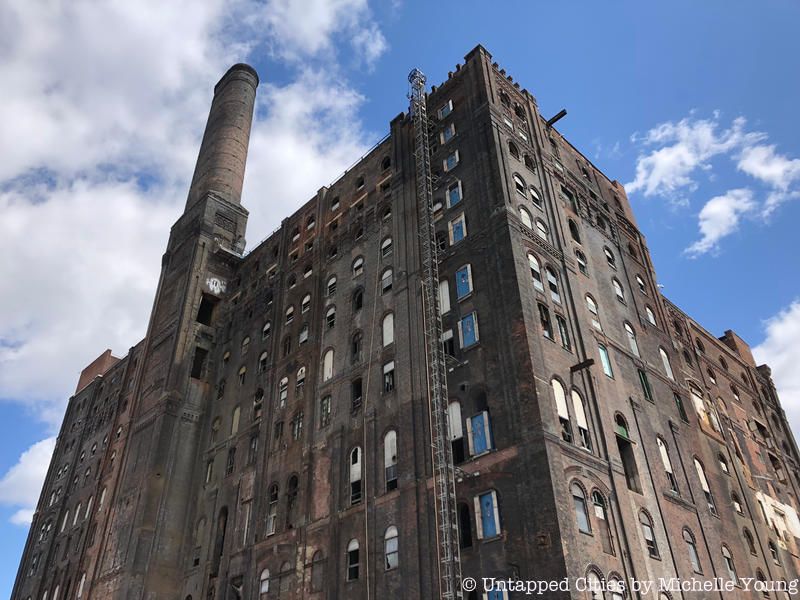
The Domino Sugar Refinery, which once dominated Brooklyn’s skyline and economy, is an urban industrial landmark built by Henry Havemeyer in the 1880s. The factory was the main site of operations for Domino Sugar until the company moved its base to Yonkers in 2004. The 3 million square foot structure where sugar was once filtered, panned, and finished, has been preserved but unused ever since. Its exterior, located at 292-314 Kent Avenue, is an individual landmark.
Beginning in 2021, the site had begun its redevelopment into retail spaces, offices, and an events space. The developer, Two Trees Management, plans to build a glass facade on the building’s top floor, which will change the exterior of the building. Currently, the developers have restored the building’s brick exterior and reinforced the building’s concrete core. The former refinery is now the heart of a 6.6-acre waterfront park situated in the new mixed-use neighborhood, built by Two Trees Management.
Next, check out 9 abandoned places to see in The Bronx and 10 abandoned places to discover in Manhattan!
Subscribe to our newsletter